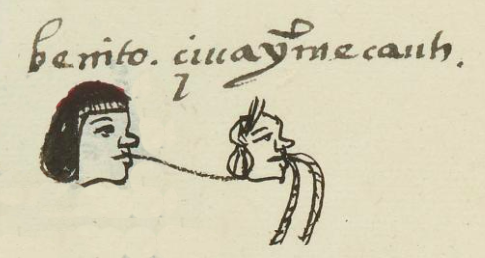Cihuainmecauh (MH660r)
This black-line drawing of the compound glyph for the personal name Cihuainmecauh (perhaps “Women’s Rope”) is attested here as a man’s name. It shows the head of a woman in profile, facing toward the viewer’s right. Coming from her mouth are two pieces of rope or cord (mecatl). Alternatively, it could be one piece and the part in her mouth is the middle, with the two ends hanging down. The rope is twisted. In the construction of the name, the mecatl has a plural possessive marker (making it women's rather than women's), but the plural is not shown visually. The woman has the hairstyle of the mature, sedentary, Nahua woman, the neaxtlahualli.
Stephanie Wood
Compare the presence of rope in the glyphs below. Ropes were used to pull stones and beams. They were also used to strangle people. The meaning of this glyph is open to speculation. Was there a rope or cord especially used by women? Were ropes used to abuse or control women? Or, was this man someone who would be led around by women? There is a range of men’s names that have the “cihua” element. These names would make an interesting study for a deeper exploration of gendered relationships.
Stephanie Wood
benito. çiuay~mecauh.
Benito Cihuainmecauh
Stephanie Wood
1560
Jeff Haskett-Wood
maxtlacuilli, ujeres, sogas, mecates, cuerdas, sogas, cordones, nombres de hombres

cihua(tl), woman, https://nahuatl.wired-humanities.org/content/cihuatl
meca(tl), rope or cord, https://nahuatl.wired-humanities.org/content/mecatl
in-, third-person plural possessive, https://nahuatl.wired-humanities.org/node/176143
Soga de Mujeres
Stephanie Wood
Matrícula de Huexotzinco, folio 660r, World Digital Library, https://www.loc.gov/resource/gdcwdl.wdl_15282/?sp=400&st=image
This manuscript is hosted by the Library of Congress and the World Digital Library; used here with the Creative Commons, “Attribution-NonCommercial-ShareAlike 3.0 License” (CC-BY-NC-SAq 3.0).


